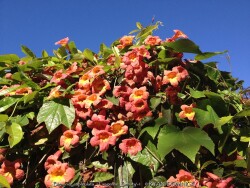

Crossvine (Bignonia capreolata) is a highly ornamented evergreen vine native to the southeast west to Oklahoma and Texas. Fantastic blooms completely cover the plant and occur on old wood in the late spring for about 3-5 weeks then sporadically during the summer. Flowers are trumpet-shaped, orange and red with yellow throats. Although in the same family as trumpet vine (campus radicans), crossvine is not invasive. Plant crossvine on fences or pergolas where you want good coverage but not anything sprawling too far away from the structure needing pruning. Considered to be one of the lowest maintenance of all vines. Crossvine prefer for part to full sun on in medium to rich soils and are able to tolerate drought and brief flooding once established. There are no serious pests or diseases to worry about. Crossvine has thrived in our Lawrence Kansas zone 6a display garden for over 15 years enduring a few occasions of -10° or colder winters. Winter foliage turns purple and remains evergreen till about -10. We have seen -18° without any dieback on the vine other than the loss of foliage that year. This great vine has it all, beautiful flowers, evergreen foliage, and constrained growth habit! Bignonia capreolata 'Tangerine Beauty' is noted for its tangerine flowers and slightly improved cold hardiness.
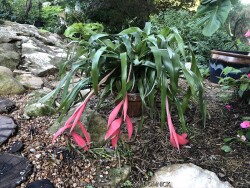

***Description for this plant available with future update!***Billbergia Bromeliad / Friendship Plant (Tropical), is also known as Billbergia nutans
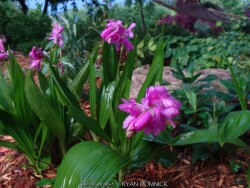

Hardy Ground Orchid (Bletilla striata) is planted for its attractive green foliage with and amazing spring flower display of pink and magenta "orchid-like" flowers. Foliage maintains well all season provided that certain cultural conditions are met. Native to Chinese forests with humusy, well-drained soil in part shade to full shade, it needs constantly moist to average soil rich in organic matter but avoid clay. If low temperatures hit -10 degrees F, it may kill an un-mulched plant; protect any zone 6 perennial with thick layer of mulch. I have occasionally seen entire plantings wiped out at -10 to15 degrees F with no mulch or snow cover. Good late summer flowering shade plant which mixes well with hostas and ferns in the shade garden. Generally this plant has declined after a few years in our Kansas display garden but worth a try in perfect soils in well-tended shade gardens.


The Brazilian Prickly Pear, also known as Brasiliopuntia brasiliensis, is a tree-like species of cacti from Brasil. It produces thin, flat, succulent leaves that resemble a prickly pear but much less thick. Originating from a dry climates but not a true desert, it is much more moisture tolerant than a typical derert barrel cactus. The main ornamental appeal is the beautiful bright green leaves (actually pads) These are popular house plants because of the ease of care, flexibility when moving in or outside for the season, and both drought and moisture tolerance. This tropical cactus has a few requirements in order to thrive but nothing too hard. Give them bright indirect light and water only when dry. If light, temperature, and humidity are sufficient, flowers may occur. If not, then just enjoy the beautiful foliage. Succulents are usually spineless and grown for their beautiful shapes, color and texture. Cacti are known for their spines, unusual shapes and beautiful flowers. Both succulents and cacti store water in their fleshy tissues. And can survive long periods without water. Cacti and succulents are usually grown as a deck/patio plant or house plant in Kansas. Grow in full sun with little to no extra watering except that which comes from rainfall. Generally, plants may be brought out in Late May through Early October in our zone 6a Lawrence, KS climate. To play is safe, potted plants are best moved in before autumn leaves begin to drop and before night temperatures get below 45 degrees F. It is very important to avoid the combination of wet and cold. Move to a bright interior window over the winter with little to no watering and keep above 50 degrees F. As a winter house plant, it will look presentable all winter long with little to no waterings. As a permanent house plant, provide bright light and allow the soil to dry completely between waterings and you will get many years of carefree enjoyment. Plants grown permanently indoors may eventually begin to elongate stretching for light and lose their spine color. It can be hard to reproduce the intense UV sunlight they need when growing indoors so moving outside for the summer is best. Generally if moving outside for the summer, allow 1-2 weeks of part shade or morning sun before placing in full sun. Plants with time to acclimate will thrive in full sun but be careful not to rush it or sunburning may occur. Repotting may or may not be needed depending on how large you want the plant to grow; plants can continue to grow taller and tolerate extremely root-bound pots but may need wind bracing. If repotting, make sure to use a sharp draining low organic cactus mix with plenty of sand and perlite but avoid peat moss. The “soil” most commercial cacti are potted in to too peaty and light weight. This soil becomes hydrophobic and shrinks after becoming bone dry and difficult to re wet again. Cacti never grow in peat-based soils in nature; this “Soil” is only good for shipping because of the light weight. Potted plants are very low maintenance but watch for scale and mealybugs that may hide beneath the cover of spines. The best pest removal approach is to periodically wash the cactus off. Achieve this with a water nozzle or hose breaker turned mostly off to increase the pressure from the blast of water. This high-pressured water kills the pests without damaging the thick cactus skin. Here are some little-known or rare factoids about cacti: 1. The "spines" are actually modified leaves filled with sap at first, then quickly drying out to form the spines! 2. Many cacti have bright colored flowers that mainly attract bees, while some tubular flowering types attract hummingbirds and bats. 3. Late on the evolutionary timeline, cacti fossils are rare to non-existent. Cacti are native almost exclusively to the Americas, while succulents can include a much larger plant palette be from any dry area in the world. 4. Some cactus plants have been known to survive more than 2 years without water. 5. Some cacti first evolved in a dry climate that later became wetter again. For example: several jungle species live as epiphytes in trees to achieve the fast drainage they need.
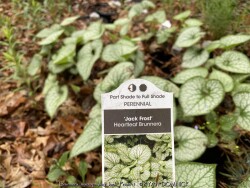

***Description for this perennial available with future update!***


***Description for this perennial available with future update!***
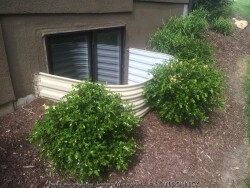

Boxwood (Buxus sp.) is a compact evergreen shrub with small round glossy green leaves. Originating in England and parts of Europe, there are many varieties ranging from small shrubs to small trees. Boxwood varieties grow rather slowly and lend themself excellently to being pruned into hedges as long as not too much is taken off at one time. After a plant achieves a certain height, you may keep it that size indefinitely with 3 to 4 times per year pruning. Boxwoods prefer part shade with rich to average well-drained soil and average moisture. Boxwoods planted in the full sun will survive but develop an burnt yellowish green color when temperatures exceed 100°F. This is usually a problem in zone 6 or further south as there are many better choices for full sun. (morning sun is okay) In zones 4-5, afternoon full sun is probably okay. Boxwoods are best known for their tolerance to dry shade even under root bound conditions. They will not survive more than a couple years under a roof overhang due to lack of moisture in the winter and spider mite problems. In the Eastern and Southeastern United States, Boxwoods have many problems including root rot, insect and disease issues. None of these are a problem in Kansas or Oklahoma with lower rainfall amounts and less humidity. In the landscape, yews offer a year-round structure. They definitely help provide a background for more interesting plants with colorful foliage and flowers. They are also very well known and used in formal garden designs. We prefer to see them less pruned and in their more natural state. Emerald Jewel Boxwood (Buxus microphylla var. koreana 'Emerald Jewel') has improved shinier light green spring foliage darkening by summer. Foliage maintains a "better" green in winter compared to other varieties. There is also no die back or twig blight problems like with Green Velvet Boxwood.
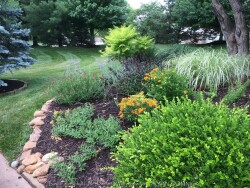

Boxwood (Buxus sp.) is a compact evergreen shrub with small round glossy green leaves. Originating in England and parts of Europe, there are many varieties ranging from small shrubs to small trees. Boxwood varieties grow rather slowly and lend themself excellently to being pruned into hedges as long as not too much is taken off at one time. After a plant achieves a certain height, you may keep it that size indefinitely with 3 to 4 times per year pruning. Boxwoods prefer part shade with rich to average well-drained soil and average moisture. Boxwoods planted in the full sun will survive but develop an burnt yellowish green color when temperatures exceed 100°F. This is usually a problem in zone 6 or further south as there are many better choices for full sun. (morning sun is okay) In zones 4-5, afternoon full sun is probably okay. Boxwoods are best known for their tolerance to dry shade even under root bound conditions. They will not survive more than a couple years under a roof overhang due to lack of moisture in the winter and spider mite problems. In the Eastern and Southeastern United States, Boxwoods have many problems including root rot, insect and disease issues. None of these are a problem in Kansas or Oklahoma with lower rainfall amounts and less humidity. In the landscape, yews offer a year-round structure. They definitely help provide a background for more interesting plants with colorful foliage and flowers. They are also very well known and used in formal garden designs. We prefer to see them less pruned and in their more natural state. Wintergreen Boxwood (Buxus microphylla var. koreana 'Wintergreen') has improved shinier light green spring foliage darkening by summer. Foliage maintains a "better" green in winter compared to other varieties. There is also no die back or twig blight problems like with Green Velvet Boxwood.


Boxwood (Buxus sp.) is a compact evergreen shrub with small round glossy green leaves. Originating in England and parts of Europe, there are many varieties ranging from small shrubs to small trees. Boxwood varieties grow rather slowly and lend themself excellently to being pruned into hedges as long as not too much is taken off at one time. After a plant achieves a certain height, you may keep it that size indefinitely with 3 to 4 times per year pruning. Boxwoods prefer part shade with rich to average well-drained soil and average moisture. Boxwoods planted in the full sun will survive but develop an burnt yellowish green color when temperatures exceed 100°F. This is usually a problem in zone 6 or further south as there are many better choices for full sun. (morning sun is okay) In zones 4-5, afternoon full sun is probably okay. Boxwoods are best known for their tolerance to dry shade even under root bound conditions. They will not survive more than a couple years under a roof overhang due to lack of moisture in the winter and spider mite problems. In the Eastern and Southeastern United States, Boxwoods have many problems including root rot, insect and disease issues. None of these are a problem in Kansas or Oklahoma with lower rainfall amounts and less humidity. In the landscape, yews offer a year-round structure. They definitely help provide a background for more interesting plants with colorful foliage and flowers. They are also very well known and used in formal garden designs. We prefer to see them less pruned and in their more natural state. Wintergreen Boxwood (Buxus microphylla var. koreana 'Wintergreen') has improved shinier light green spring foliage darkening by summer. Foliage maintains a "better" green in winter compared to other varieties. There is also no die back or twig blight problems like with Green Velvet Boxwood.
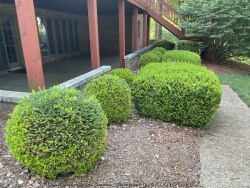

Boxwood (Buxus sp.) is a compact evergreen shrub with small round glossy green leaves. Originating in England and parts of Europe, there are many varieties ranging from small shrubs to small trees. Boxwood varieties grow rather slowly and lend themself excellently to being pruned into hedges as long as not too much is taken off at one time. After a plant achieves a certain height, you may keep it that size indefinitely with 3 to 4 times per year pruning. Boxwoods prefer part shade with rich to average well-drained soil and average moisture. Boxwoods planted in the full sun will survive but develop an burnt yellowish green color when temperatures exceed 100°F. This is usually a problem in zone 6 or further south as there are many better choices for full sun. (morning sun is okay) In zones 4-5, afternoon full sun is probably okay. Boxwoods are best known for their tolerance to dry shade even under root bound conditions. They will not survive more than a couple years under a roof overhang due to lack of moisture in the winter and spider mite problems. In the Eastern and Southeastern United States, Boxwoods have many problems including root rot, insect and disease issues. None of these are a problem in Kansas or Oklahoma with lower rainfall amounts and less humidity. In the landscape, yews offer a year-round structure. They definitely help provide a background for more interesting plants with colorful foliage and flowers. They are also very well known and used in formal garden designs. We prefer to see them less pruned and in their more natural state.


With its glossy burgundy-red foliage, Red Zeppelin sweetshrub (Calycanthus floridus var. purpureus) will rock your world! The color of the foliage lasts all season and is accompanied by lightly fragrant orange-red flowers in late spring and early summer. Not only is it adaptable and easy to grow in the landscape, but our many years of trialing indicate it’s easy to grow in production, too. This selection of our North American native species was developed by the folks at Pleasant Run Nursery. Prune after flowering to maintain shape. Calycanthus perform amazingly well in eastern Kansas landscapes. It is great along a woodland edge or in morning sun, or in full sun for best foliage color show. It tolerates a wide variety of soil types including clay but needs prefers well-drained soil high in organic matter. Adaptable to mild drought and heat but greatly improved with rich, moisture-retentive soils. Typically, our 40 inches of rainfall per year in Eastern Kansas is sufficient. Summer foliage is virtually pest-free. All Proven Winners® plants are legally propagated, healthy and vigorous, true to name, and tagged with color pictures and growing information.
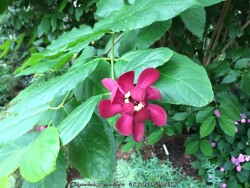

Aphrodite Sweetshrub (Calycanthus x 'Aphrodite') is covered in big, glossy, medium-green leaves. This shrub explodes with enormous cupped flowers that look a bit like a deep red magnolia. They start in early summer with a big flush of flowers continuing to bloom sporadically all summer long. This is a quite large shrub that needs plenty of space to look its best, but if you have the room for it, there are few better ways to use it! 'Aphrodite' is a hybrid between our native Calycanthus and the Asian species, x Sinocalycanthus. You're probably wondering if it's fragrant, and the answer is - it depends. The scent varies based on the age of the bloom, the time of day, and the flower itself. Some people say they smell like pineapple, others apples, others bubblegum, and some get no scent at all. Even if you never sense a whiff off this plant, its fabulous flowers are more than enough reward. Prune after flowering to maintain shape. This Calycanthus performs amazingly well in eastern Kansas landscapes. It is great along a woodland edge or in morning sun. When planted in full shade with rich soil in our Lawrence, KS Zone 6a display garden, growth is very rapid and flowers completely cover the shrub for a few weeks in early summer. Yes, you heard right, this shrub is will flower in full shade. It tolerates a wide variety of soil types including clay but needs prefers well-drained soil high in organic matter. Adaptable to mild drought and heat (plant in full shade in southern zones) but greatly improved with rich, moisture-retentive soils. Typically, our 40 inches of rainfall per year in Eastern Kansas is sufficient. Summer foliage is virtually pest-free. All Proven Winners® plants are legally propagated, healthy and vigorous, true to name, and tagged with color pictures and growing information.


The Saguaro Cactus (Carnegiea gigantea) is probably the most well known iconic cactus out there. Native to the Sonoran Desert in Arizona and Mexico, it's usually grown as a patio or house plant in Kansas. In the wild, established saguaro cacti are hardy to 15 degrees F for short periods of time making them the most cold tolerant columnar tree cactus out there. Growth rates are astonishingly slow: a plant the size od a softball may already be 10-15 years old. A 12" tall specimen may be 20-30 years old. The first arm usually develops around 75 years and plants can live for 200-300 years in hte wild. Grow in full sun with no extra watering except that which comes from rainfall. Repotting may or may not be needed depending on how large you want the plant to grow; plants can continue to grow taller and tolerate extremely root-bound pots but may need wind bracing. If repotting, make sure to use a sharp draining low organic cactus mix with plenty of sand and perlite. Potted plants are hardy to at least 30 degrees F for a short time if kept dry so you are ok if you miss the first light frost. Do not allow the pot with rootball to freeze solid though. Before extreme cold occurs, move to a bright interior window over the winter with no watering and keep above freezing. As a winter house plant, it will look presentable all winter long with just no waterings.(also to prevent soft winter growth) As a permanent house plant, provide bright light and allow the soil to dry between waterings for many years of carefree enjoyment. Plants grown permanently indoors may begin to elongate stretching for light and lose their spine color. It can be hard to reproduce the intense UV sunlight they need so moving outside for the summer is best. Generally if moving outside for the summer, allow 1-2 weeks of part shade or morning sun before placing in full sun. Plants with time to acclimate will thrive in full sun but be careful not to rush it or sunburning will occur. Potted plants are very low maintenance. I have never seen any insect problems on this plant.
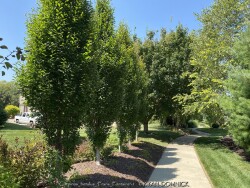

***Tree descriptions available with future update!***
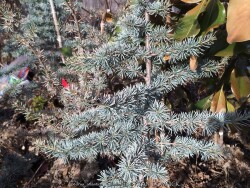

Blue Atlas Cedar (Cedrus atlantica 'Glauca') is an outstanding ornamental conifer tree with the characteristic conical shape and bluish-silver color. Foliage density is very compact along the branches but with plenty of space between branches, enough to show off the wonderful architectural branching structure of the tree. It is cold and drought tolerant enough to survive in much of Kansas with mature specimens (15-30' tall) occasionally seen in Lawrence and Kansas City. In Eastern Kansas, typically our 40 inches of rainfall is sufficient without extra water if planted in good soils. Avoid poorly drained clay soils especially that hold water for more than a day. Numerous cultivar selections are available, many for improved blue color of the needles or different growth forms. There is at least one "weeping" selection that I have witnessed prospering in Lawrence, KS for many years surviving -16 degrees F and a week of single digit highs in February, 2021.
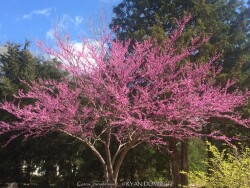

***Tree descriptions available with future update!***Eastern Redbud, is also known as Cercis canadensis
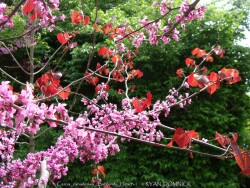

Cercis canadensis Burgundy Hearts® is an improved reddish purple-leaf variety developed by Greenleaf Nurseries in Oklahoma. Burgundy Hearts more drought and heat tolerant. Pinkish-lavender April flowers bloom for about a month before leaves appear. It has a more or less rounded form, wider than it is tall. This small deciduous tree is known for its heart-shaped leaves that hold their dark color longer in the summer, taking on reddish wine tones towards the fall. Many of the problems with the regular species redbud tree are not an issue with this improved cultivar. It is to be expected however that all Redbuds have a relatively short lifespan of 20-40 years but even so, are worth planting for its beautiful flowers. It is not weak wooded and makes a nice hot non-sparking firewood. The short life span is not due to breakage so much as it is to the tree's susceptibility to heart-rot especially when branch crotches form and get older. Other problems include canker, verticillium wilt and root rot. Most redbud varieties thrive in full sun to partial shade. They will tolerate full shade but become elongated and thin as they reach for the sun. Redbuds do well in most soil types but adequate drainage is a must; it can tolerate dry shade of Eastern Kansas forests receiving at least 35" of rainfall per year. The species is a native from southern Canada to Florida, east to Kansas. The regular species also has the potential to self seed in your yard but not Burgundy Hearts. As a dwarf tree, use 'Merlot' as a specimen or part of a group. It reaches about 20 to 30 feet high and wide in full sun. Reddish leaf color emerges in the spring and is maintained all summer long if in mostly full sun. The color of older purple redbuds (like Forest Pansy) fades to dark green as the summer heat intensifies.
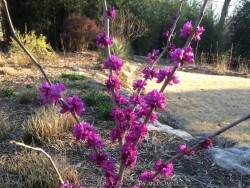

Don Egolf Redbud (Cercis canadensis 'Don Egolf') is a dwarf flowering shrub redbud native to China. It has the typical heart shaped green Redbud foliage and deep magenta flowers. The bark is more of a beige or light tan color with black buds. Flowering begins in April with flower buds starting on old wood all the way to the ground level. Flowering even occurs on very young plants only several inches tall. Because this is a Chinese species, no seed pods form like on native Redbuds. After many years, heights of 8 to 10 feet may be achieved on multi-stemmed plants. Culture conditions are pretty easy; just provide average garden soil, reasonable water, and mostly sun. In Eastern Kansas, typically our 40 inches of rainfall is sufficient without extra water if planted in good soils. Don Eagles Red has been growing in our display garden for over 10 years blooming consistently with no problems. It survived -16 degrees F and a week of single digit highs in February, 2021 with no damage to flower buds.
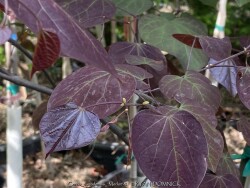

This purple-leaf Redbud (Cercis canadensis 'Merlot') is a canadensis and texensis cross to produce a more drought and heat tolerant tree. It has glossy, small rounded dark purple leaves and has an upright vase-shaped growth habit. This small deciduous tree is known for its stunning display of colorful blooms a deep magenta color. Many of the problems with the regular species redbud tree are not an issue with this improved cultivar. It is to be expected however that all Redbuds have a relatively short lifespan of 20-40 years but even so, are worth planting for its beautiful flowers. It is not weak wooded and makes a nice hot non-sparking firewood. The short life span is not due to breakage so much as it is to the tree's susceptibility to heart-rot especially when branch crotches form and get older. Other problems include canker, verticillium wilt and root rot. Most redbud varieties thrive in full sun to partial shade. They will tolerate full shade but become elongated and thin as they reach for the sun. Redbuds do well in most soil types but adequate drainage is a must; it can tolerate dry shade of Eastern Kansas forests receiving at least 35" of rainfall per year. The species is a native from southern Canada to Florida, east to Kansas. The regular species also has the potential to self seed in your yard but not 'Merlot'. As a dwarf tree, use 'Merlot' as a specimen or part of a group. It reaches about 12 to 15 feet high and wide in full sun. Reddish leaf color emerges in the spring and is maintained all summer long if in mostly full sun. The color of older purple redbuds (like Forest Pansy) fades to dark green as the summer heat intensifies.
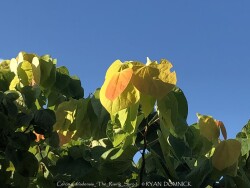

***Tree descriptions available with future update!***
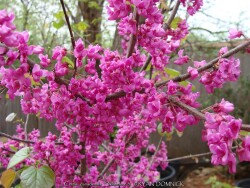

***Tree descriptions available with future update!***
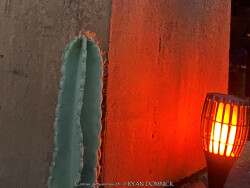

Grown for its beautiful bluish-green skin and showy night-blooming white flowers. Unlike most columnar cacti, Peruvian apple cactus (Cereus peruvianus) will bloom at a young age in a pot when about 3' tall or more. This cactus is usually grown as a patio or house plant in Kansas and blooms in late summer into early fall. Flowers only last one night! In the wild, this species is hardy to 20-25 degrees F for short periods of time. Grow in full sun with optional extra watering including that which comes from rainfall. Potted plants are very low maintenance. I have never seen any insect problems on this plant. Potted plants are capable of growing 10' tall or more in a small 7gal pot. Succulents are usually spineless and grown for their beautiful shapes, color and texture. Cacti are known for their spines, unusual shapes and beautiful flowers. Both succulents and cacti store water in their fleshy tissues. And can survive long periods without water. Cacti and succulents are usually grown as a deck/patio plant or house plant in Kansas. Grow in full sun with little to no extra watering except that which comes from rainfall. Generally, plants may be brought out in Late May through Early October in our zone 6a Lawrence, KS climate. To play is safe, potted plants are best moved in before autumn leaves begin to drop and before night temperatures get below 45 degrees F. It is very important to avoid the combination of wet and cold. Move to a bright interior window over the winter with little to no watering and keep above 50 degrees F. As a winter house plant, it will look presentable all winter long with little to no waterings. As a permanent house plant, provide bright light and allow the soil to dry completely between waterings and you will get many years of carefree enjoyment. Plants grown permanently indoors may eventually begin to elongate stretching for light and lose their spine color. It can be hard to reproduce the intense UV sunlight they need when growing indoors so moving outside for the summer is best. Generally if moving outside for the summer, allow 1-2 weeks of part shade or morning sun before placing in full sun. Plants with time to acclimate will thrive in full sun but be careful not to rush it or sunburning may occur. Repotting may or may not be needed depending on how large you want the plant to grow; plants can continue to grow taller and tolerate extremely root-bound pots but may need wind bracing. If repotting, make sure to use a sharp draining low organic cactus mix with plenty of sand and perlite but avoid peat moss. The “soil” most commercial cacti are potted in to too peaty and light weight. This soil becomes hydrophobic and shrinks after becoming bone dry and difficult to re wet again. Cacti never grow in peat-based soils in nature; this “Soil” is only good for shipping because of the light weight. Potted plants are very low maintenance but watch for scale and mealybugs that may hide beneath the cover of spines. The best pest removal approach is to periodically wash the cactus off. Achieve this with a water nozzle or hose breaker turned mostly off to increase the pressure from the blast of water. This high-pressured water kills the pests without damaging the thick cactus skin. Here are some little-known or rare factoids about cacti: 1. The "spines" are actually modified leaves filled with sap at first, then quickly drying out to form the spines! 2. Many cacti have bright colored flowers that mainly attract bees, while some tubular flowering types attract hummingbirds and bats. 3. Late on the evolutionary timeline, cacti fossils are rare to non-existent. Cacti are native almost exclusively to the Americas, while succulents can include a much larger plant palette be from any dry area in the world. 4. Some cactus plants have been known to survive more than 2 years without water. 5. Some cacti first evolved in a dry climate that later became wetter again. For example: several jungle species live as epiphytes in trees to achieve the fast drainage they need.


Grown for its beautiful bluish-green skin and showy night-blooming white flowers. Unlike most columnar cacti, Peruvian apple cactus (Cereus peruvianus) will bloom at a young age in a pot when about 3' tall or more. This cactus is usually grown as a patio or house plant in Kansas and blooms in late summer into early fall. Flowers only last one night! In the wild, this species is hardy to 20-25 degrees F for short periods of time. Grow in full sun with optional extra watering including that which comes from rainfall. Potted plants are very low maintenance. I have never seen any insect problems on this plant. Potted plants are capable of growing 10' tall or more in a small 7gal pot. Succulents are usually spineless and grown for their beautiful shapes, color and texture. Cacti are known for their spines, unusual shapes and beautiful flowers. Both succulents and cacti store water in their fleshy tissues. And can survive long periods without water. Cacti and succulents are usually grown as a deck/patio plant or house plant in Kansas. Grow in full sun with little to no extra watering except that which comes from rainfall. Generally, plants may be brought out in Late May through Early October in our zone 6a Lawrence, KS climate. To play is safe, potted plants are best moved in before autumn leaves begin to drop and before night temperatures get below 45 degrees F. It is very important to avoid the combination of wet and cold. Move to a bright interior window over the winter with little to no watering and keep above 50 degrees F. As a winter house plant, it will look presentable all winter long with little to no waterings. As a permanent house plant, provide bright light and allow the soil to dry completely between waterings and you will get many years of carefree enjoyment. Plants grown permanently indoors may eventually begin to elongate stretching for light and lose their spine color. It can be hard to reproduce the intense UV sunlight they need when growing indoors so moving outside for the summer is best. Generally if moving outside for the summer, allow 1-2 weeks of part shade or morning sun before placing in full sun. Plants with time to acclimate will thrive in full sun but be careful not to rush it or sunburning may occur. Repotting may or may not be needed depending on how large you want the plant to grow; plants can continue to grow taller and tolerate extremely root-bound pots but may need wind bracing. If repotting, make sure to use a sharp draining low organic cactus mix with plenty of sand and perlite but avoid peat moss. The “soil” most commercial cacti are potted in to too peaty and light weight. This soil becomes hydrophobic and shrinks after becoming bone dry and difficult to re wet again. Cacti never grow in peat-based soils in nature; this “Soil” is only good for shipping because of the light weight. Potted plants are very low maintenance but watch for scale and mealybugs that may hide beneath the cover of spines. The best pest removal approach is to periodically wash the cactus off. Achieve this with a water nozzle or hose breaker turned mostly off to increase the pressure from the blast of water. This high-pressured water kills the pests without damaging the thick cactus skin. Here are some little-known or rare factoids about cacti: 1. The "spines" are actually modified leaves filled with sap at first, then quickly drying out to form the spines! 2. Many cacti have bright colored flowers that mainly attract bees, while some tubular flowering types attract hummingbirds and bats. 3. Late on the evolutionary timeline, cacti fossils are rare to non-existent. Cacti are native almost exclusively to the Americas, while succulents can include a much larger plant palette be from any dry area in the world. 4. Some cactus plants have been known to survive more than 2 years without water. 5. Some cacti first evolved in a dry climate that later became wetter again. For example: several jungle species live as epiphytes in trees to achieve the fast drainage they need.
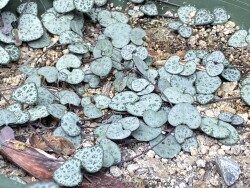

Ceropegia woodii known as the Rosary Vine and String of Hearts. This unusual, hardy vining succulent produces pretty, variegated, heart-shaped leaves with purple undersides on tough, wire-like stems. They are usually grown as a patio or house plant in Kansas. String of Hearts also grow well in hanging baskets as a durable, succulent plant able to survive drying out, heat and dry air like few others! If conditions get too rough, the foliage simply dies back and growth returns from underground tubers when favorable conditions return. To play is safe, potted plants are best moved in before night temperatures get below 45 degrees F. It is important to avoid the combination of wet and cold. Before extreme cold occurs, move to a bright interior window over the winter with no watering and keep above freezing. As a winter house plant, it will look presentable all winter long with just no waterings. As a permanent house plant, provide bright light and allow the soil to dry between waterings for many years of carefree enjoyment. Plants grown permanently indoors may begin to elongate stretching for light producing weak new growth. It can be hard to reproduce the intense UV sunlight they need so moving outside for the summer is best. Generally if moving outside for the summer, allow 1-2 weeks of part shade or morning sun before placing in full sun. Plants with time to acclimate will thrive in full sun but be careful not to rush it or sunburning will occur. Potted plants are very low maintenance. I have never seen any insect problems on this plant.
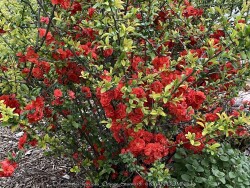

Double Take® Orange Quince (Chaenomeles 'Double Take Orange') features huge flowers on a thornless plant. It's so beautiful you may overlook its survivalist skills! Heat and drought tolerant, this plant will delight you each spring with candy colored blooms. Double Take Orange puts on a spectacular spring display of large double flowers with intense orange color - you'll do a double take! More than just pretty flowers, the Double Take Quinces are easy to care for, having neither thorns or fruit. Once established, they are extremely drought tolerant. Developed by Dr. Tom Ranney and his team at the Mountain Crops Research & Extension Center in beautiful North Carolina, Orange Storm and the other Double Take Quinces are sure to brighten spring gardens across the United States. Uses Notes: Excellent for hedging, mass planting and cut flower gardens. A spectacular early season specimen for the mixed border. Maintenance Notes: Prune to shape after flowering. Apply a controlled release fertilizer in spring. Formerly known as Double Take 'Orange Storm' quince. In Eastern Kansas, this cultivar performs WELL with just about everything nature has to challenge it! Heat and drought are tolerated reasonably well but with some foliage decline by late summer and no fall color. This is made up for by the extremely reliable blooming season that fills up the month of April when many other plants are not in full swing yet. Cold tolerance or flower bud loss is no problem in our zone 6. No serious disease or pest problems. All Proven Winners® plants are legally propagated, healthy and vigorous, true to name, and tagged with color pictures and growing information.


Double Take® Pink Quince (Chaenomeles 'Double Take Pink') features huge flowers on a thornless plant! You'll do a double take when you see this quince that looks like a camellia. Double Take Pink puts on a spectacular early season display of pink blooms. The large, double flowers are excellent in cut flower arrangements. Bright spring flowers are only the beginning of the Double Take quince's appeal: they're also thornless, and do not produce fruit. Extremely drought tolerant once established, these early spring charmers are excellent landscape plants and real survivalists in tough climates. Developed by Dr. Tom Ranney and his team at the Mountain Horticultural Crops Research & Extension Center in beautiful North Carolina, they are sure to brighten spring landscapes across the United States.Uses Notes: Intense early spring color is excellent for mixed borders and cutting gardens. Also good for hedging and mass plantings. Maintenance Notes: Trim to shape after flowering. Apply a controlled release fertilizer in spring. Formerly sold as Double Take 'Pink Storm' quince. In Eastern Kansas, this cultivar performs WELL with just about everything nature has to challenge it! Heat and drought are tolerated reasonably well but with some foliage decline by late summer and no fall color. This is made up for by the extremely reliable blooming season that fills up the month of April when many other plants are not in full swing yet. Cold tolerance or flower bud loss is no problem in our zone 6. No serious disease or pest problems. All Proven Winners® plants are legally propagated, healthy and vigorous, true to name, and tagged with color pictures and growing information.
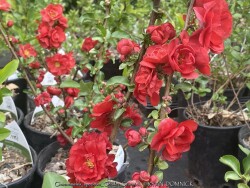

You'll do a double take when you see this quince that looks like a camellia. Double Take Scarlet Quince (Chaenomeles 'Double Take Scarlet') puts on a spectacular early spring display of large red, double flowers. The Double Take quinces are more than just pretty spring flowers: thornless and deer-resistant, they do not produce fruit, and once established, are drought-tolerant survivalists. Developed by Dr. Tom Ranney and his team at the Mountain Horticultural Crops Research & Extension Center in beautiful North Carolina, the Double Take quinces are sure to brighten spring landscapes across the United States. Uses Notes: Bright early spring flowers are great in mixed borders or cutting gardens. Also good for hedging and mass plantings. Maintenance Notes: Trim to shape after flowering. Apply a controlled release fertilizer in early spring. Formerly sold as Double Take 'Scarlet Storm' quince. In Eastern Kansas, this cultivar performs WELL with just about everything nature has to challenge it! Heat and drought are tolerated reasonably well but with some foliage decline by late summer and no fall color. This is made up for by the extremely reliable blooming season that fills up the month of April when many other plants are not in full swing yet. Cold tolerance or flower bud loss is no problem in our zone 6. No serious disease or pest problems. All Proven Winners® plants are legally propagated, healthy and vigorous, true to name, and tagged with color pictures and growing information.
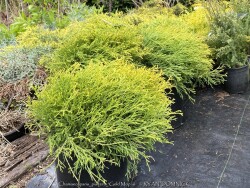

Gold Mop False Cypress (Chamaecyparis pisifera 'Gold Mop') is from a group of small coniferous shrubs from Asia with Juniper-like foliage. The foliage is bright yellow, thread-like and creates a relatively low, semi-weeping habit. It provides consistent color during spring, summer, fall, and darkens to a more gold color by winter providing excellent color when most other plants are dormant. Full sun and average garden conditions are preferred. Maintenance is pretty easy, only prune when needed to control size. Do not prune in late summer or fall. Coloring is definitely best if the plant can receive winter sun. Combine in the summer with other flowering perennials and shrubs. Combine in the winter with ornamental grasses, yuccas, Nandinas, or winter interest plants that contrast with gold.


***Description for this plant available with future update!***


***Description for this plant available with future update!***Milky Way Spider Plant (Tropical), is also known as Chlorophytum comosum 'Milky Way'
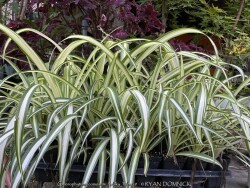

***Description for this plant available with future update!***Milky Way Spider Plant (Tropical), is also known as Chlorophytum comosum 'Milky Way'
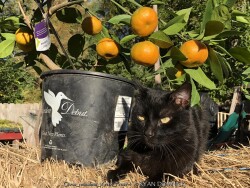

Arctic Frost Hardy Satsuma (Citrus reticulata 'Arctic Frost') is typically grown in warmer zones as far North as Dallas (Zone 8a). Along with other tropicals and succulents in Kansas, Arctic Frost is usually grown as summer patio plant and then moved inside for the winter. Move to bright area in a cold garage, basement, or window over the winter with monthly watering. During the growing season, water regularly and place in full sun. If grown in a larger 20 gallon pot or so, it may flower and fruit when 4-5 feet tall after a few years. Before hard freezes come in the fall, move inside to protect from temperatures below 25 degrees F if you want fruit. Flower buds form in the winter on citrus trees. If you want evergreen foliage, protect with anything lower than 15 degrees F. It will tolerate down to 10 degrees F with complete defoliation and around 0 degrees F with complete wood kill down to the base of the trunk. Because it is grown on its own root system, it will come back true from winter kill down to the ground. A plant in our Lawrence, KS cold frame survived 0 degrees F for a few days and grew 3-4' back the following year. Don't expect flowers and fruit in these conditions though.
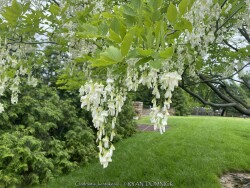

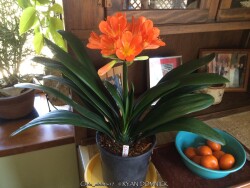

Clivia (Clivia miniata) has attractive dark green, wide, glossy, curved foliage along with long lasting bright orange flowers followed by red fruits. Also sometimes called Bush lily or Kaffir lily, it is native to seasonal semi-dry woodland habitats in South Africa. It is best used as a houseplant or full-shade summer patio plant in Kansas. Place in full shade in areas where occasional extra watering can happen including that which comes from rainfall. Repotting may or may not be needed depending on how large you want the plant to grow; plants can continue to grow thicker and tolerate extremely root-bound pots. Potted plants are hardy to at least 30 degrees F for a short time but try not to miss the first light frost. Move into a cold garage, basement, or bright window over the winter with occasional to no watering. Flowering is more reliable with root-bound plants given a cool 2-4 month dormant season with temperatures in the 40-50 degree F range with little to no winter watering. Larger plants can survive 3-5 months without water in the winter if allowed to have a healthy outdoor growing season. As a winter house plant, it will look presentable all winter long with just a few waterings. As a permanent house plant, provide bright light and allow the soil to dry between waterings for many years (even decades) of carefree enjoyment. Potted plants grow very slow and are very low maintenance needing only old leaves removed once per year. Mealy bugs can be a problem with permanent indoor house plants but will go away if grown outside during the summer or never introduced in the first place. Either way, take outside and administer sharp blasts of hose water and/or horticultural oil spray to eliminate this (only) pest problem. Note that clivia will sunburn rapidly if accidently left in full sun even for a few hours, even in cooler weather in spring or fall so be aware of its needs and protect from all direct outdoor sunlight. Indoor grown plants however, can handle direct sun (UV blocked light) from windows. Clivia is relatively rare and will command a higher price than most other houseplants.
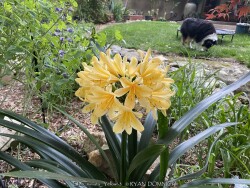

Clivia (Clivia miniata) has attractive dark green, wide, glossy, curved foliage along with long lasting bright yellow flowers followed by red fruits. Also sometimes called Bush lily or Kaffir lily, it is native to seasonal semi-dry woodland habitats in South Africa. It is best used as a houseplant or full-shade summer patio plant in Kansas. Place in full shade in areas where occasional extra watering can happen including that which comes from rainfall. Repotting may or may not be needed depending on how large you want the plant to grow; plants can continue to grow thicker and tolerate extremely root-bound pots. Potted plants are hardy to at least 30 degrees F for a short time but try not to miss the first light frost. Move into a cold garage, basement, or bright window over the winter with occasional to no watering. Flowering is more reliable with root-bound plants given a cool 2-4 month dormant season with temperatures in the 40-50 degree F range with little to no winter watering. Larger plants can survive 3-5 months without water in the winter if allowed to have a healthy outdoor growing season. As a winter house plant, it will look presentable all winter long with just a few waterings. As a permanent house plant, provide bright light and allow the soil to dry between waterings for many years (even decades) of carefree enjoyment. Potted plants grow very slow and are very low maintenance needing only old leaves removed once per year. Mealy bugs can be a problem with permanent indoor house plants but will go away if grown outside during the summer or never introduced in the first place. Either way, take outside and administer sharp blasts of hose water and/or horticultural oil spray to eliminate this (only) pest problem. Note that clivia will sunburn rapidly if accidently left in full sun even for a few hours, even in cooler weather in spring or fall so be aware of its needs and protect from all direct outdoor sunlight. Indoor grown plants however, can handle direct sun (UV blocked light) from windows. Yellow clivia is rare and will command a higher price than most other houseplants.


Clivia (Clivia miniata) has attractive dark green, wide, glossy, curved foliage along with long lasting bright orange flowers followed by red fruits. Also sometimes called Bush lily or Kaffir lily, it is native to seasonal semi-dry woodland habitats in South Africa. It is best used as a houseplant or full-shade summer patio plant in Kansas. Place in full shade in areas where occasional extra watering can happen including that which comes from rainfall. Repotting may or may not be needed depending on how large you want the plant to grow; plants can continue to grow thicker and tolerate extremely root-bound pots. Potted plants are hardy to at least 30 degrees F for a short time but try not to miss the first light frost. Move into a cold garage, basement, or bright window over the winter with occasional to no watering. Flowering is more reliable with root-bound plants given a cool 2-4 month dormant season with temperatures in the 40-50 degree F range with little to no winter watering. Larger plants can survive 3-5 months without water in the winter if allowed to have a healthy outdoor growing season. As a winter house plant, it will look presentable all winter long with just a few waterings. As a permanent house plant, provide bright light and allow the soil to dry between waterings for many years (even decades) of carefree enjoyment. Potted plants grow very slow and are very low maintenance needing only old leaves removed once per year. Mealy bugs can be a problem with permanent indoor house plants but will go away if grown outside during the summer or never introduced in the first place. Either way, take outside and administer sharp blasts of hose water and/or horticultural oil spray to eliminate this (only) pest problem. Note that clivia will sunburn rapidly if accidently left in full sun even for a few hours, even in cooler weather in spring or fall so be aware of its needs and protect from all direct outdoor sunlight. Indoor grown plants however, can handle direct sun (UV blocked light) from windows. Clivia is relatively rare and will command a higher price than most other houseplants.


Clivia (Clivia miniata) has attractive dark green, wide, glossy, curved foliage along with long lasting bright orange flowers followed by red fruits. Also sometimes called Bush lily or Kaffir lily, it is native to seasonal semi-dry woodland habitats in South Africa. It is best used as a houseplant or full-shade summer patio plant in Kansas. Place in full shade in areas where occasional extra watering can happen including that which comes from rainfall. Repotting may or may not be needed depending on how large you want the plant to grow; plants can continue to grow thicker and tolerate extremely root-bound pots. Potted plants are hardy to at least 30 degrees F for a short time but try not to miss the first light frost. Move into a cold garage, basement, or bright window over the winter with occasional to no watering. Flowering is more reliable with root-bound plants given a cool 2-4 month dormant season with temperatures in the 40-50 degree F range with little to no winter watering. Larger plants can survive 3-5 months without water in the winter if allowed to have a healthy outdoor growing season. As a winter house plant, it will look presentable all winter long with just a few waterings. As a permanent house plant, provide bright light and allow the soil to dry between waterings for many years (even decades) of carefree enjoyment. Potted plants grow very slow and are very low maintenance needing only old leaves removed once per year. Mealy bugs can be a problem with permanent indoor house plants but will go away if grown outside during the summer or never introduced in the first place. Either way, take outside and administer sharp blasts of hose water and/or horticultural oil spray to eliminate this (only) pest problem. Note that clivia will sunburn rapidly if accidently left in full sun even for a few hours, even in cooler weather in spring or fall so be aware of its needs and protect from all direct outdoor sunlight. Indoor grown plants however, can handle direct sun (UV blocked light) from windows. Clivia is relatively rare and will command a higher price than most other houseplants.
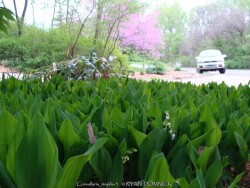

Lily of the Valley (Convallaria majalis) is planted for its elliptic shiny green leaves and white aromatic bell-shaped flowers. Foliage maintains well all summer provided that certain cultural conditions are met. Native to Europe, it colonizes forests and can be invasive in parts of the northern US but not so much in Kansas. It can spread rapidly in humusy, medium well-drained soil in part shade to full shade. It can handle some Kansas drought in in moisture-retentive soils but not dry-shade. Foliage will flatten to the ground during drought then spring back up when moisture is available again. Generally however, in non-irrigated or poor soil areas, this plant will decline and allow weeds to intermix. As far as Kansas landscape uses, Lily of the Valley can form a dense, weed resistant groundcover in rich soils, but also spread into other plants. Don't mix with other perennials or groundcovers; shrubs and taller perennials such as hostas are ok. Spring scented flowers are quite attractive combining well with the dark green foliage and thus very popular in woodland gardens.


***Shrub descriptions available with future update!***Harry Lauder's Walking Stick / Contorted Filbert, is also known as Corylus avellana 'Contorta'


***Description for this plant available with future update!*** With extremely well drained soils and proper siting, this cactus seems to take our excess rainfall in Eastern Kansas. These and other hardy barrel cacti are perfect for a dry mounded xeriscape gardens under south facing roof overhangs where it gets no winter moisture. We are also testing this outside in our Lawrence, KS (zone 6a) crevice garden among other cold-hardy cacti, succulents, and yucca! Watch for future updates-Jan-2025
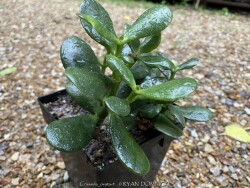

Jade Plant (Crassula ovata) is typically grown in warmer zones. Considered a tropical or succulent in Kansas and used as summer patio plants with white flowers and bright green foliage. Grow in full sun to part sun with optional extra watering during hot weather including that which comes from rainfall. Plants with plenty of time to acclimate will thrive in full sun but be careful not to rush it or sunburning will occur. Generally if moving outside for the summer, allow 2-3 weeks of part shade or morning sun before placing in full sun. Or just keep in part shade or under an overhang. Repotting may or may not be needed depending on how large you want the plant to grow; plants can continue to grow and tolerate extremely root-bound pots but may need wind bracing. Jade Plant can tolerate brief frosts but protect from temperatures below 29 degrees F for more than a few hours. As a permanent house plant, provide bright light and allow the soil to dry between waterings for many years of carefree enjoyment. Potted plants are very low maintenance but the combination of wet and cold will cause problems.
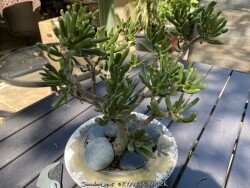

Jade Plant (Crassula ovata) is typically grown in warmer zones. Considered a tropical or succulent in Kansas and used as summer patio plants with white flowers and bright green foliage. Grow in full sun to part sun with optional extra watering during hot weather including that which comes from rainfall. Plants with plenty of time to acclimate will thrive in full sun but be careful not to rush it or sunburning will occur. Generally if moving outside for the summer, allow 2-3 weeks of part shade or morning sun before placing in full sun. Or just keep in part shade or under an overhang. Repotting may or may not be needed depending on how large you want the plant to grow; plants can continue to grow and tolerate extremely root-bound pots but may need wind bracing. Jade Plant can tolerate brief frosts but protect from temperatures below 29 degrees F for more than a few hours. As a permanent house plant, provide bright light and allow the soil to dry between waterings for many years of carefree enjoyment. Potted plants are very low maintenance but the combination of wet and cold will cause problems. The 'Hobbit' variety has an interesting mutation giving it the appearance of having its leaves rolled up and fused together. Hobbit jade (Crassula ovata 'Hobbit') is relatively rare and will command a higher price than most other houseplants.


Red Burst Bromeliad (Cryptbergia 'Red Burst') is an intergeneric bromeliad hybrid that is a cross between Billbergia nutans x Cryptanthus bahianus. It forms rosettes of flattened 8-12" long pointed green/bronzy-red leaves. Color ranges from dark green in shade to more intense maroon in bright UV light. 'Red Burst' is usually grown as a patio or house plant in Kansas. Best grown in full to part sun with some extra watering including that which comes from rainfall. Repotting may or may not be needed depending on how large you want the plant to grow; plants can continue to grow thicker and tolerate extremely root-bound pots and bone dry soil. If repotting, make sure to use a cactus mix with some of sand and perlite. Although plants are hardy to 26-28 degrees F, potted plants are best moved in before night temperatures get below 35 degrees F. It is important to avoid the combination of wet and cold. Move to a bright interior window over the winter with no watering and keep above freezing. As a winter house plant, it will look presentable all winter long with just no waterings. As a permanent house plant, provide bright light and allow the soil to dry between waterings for many years of carefree enjoyment. Plants grown permanently indoors may begin to lose foliage color. It can be hard to reproduce the intense UV sunlight they need so moving outside for the summer is best. Generally if moving outside for the summer, allow 1-2 weeks of part shade or morning sun before placing in full sun. Plants with time to acclimate will thrive in full sun but be careful not to rush it or sunburning will occur. Potted plants are very low maintenance; no pests have ever been observed on this bullet-proof plant.
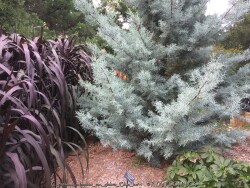

Blue Ice Arizona Cypress (Cupressus arizonica var. glabra 'Blue Ice') is a relatively new plant being used in Kansas zone 6. Originally native to desert areas of the Southwest and Mexico including dry mountain slopes, it seems pretty well adapted to our climate without many of the traditional pests that plague evergreens. Several 15-20 foot tall specimens can be observed in the Wichita botanical garden, Botanica. 'Blue Ice' Arizona Cypress is grown for its bluish nearly silver foliage, unique conical (pyramidal when young) growth form, and occasional silver fruit. Drainage definitely needs to be on the positive side but most soils seem okay. Planting on a South or West foundation is perfect. (or on a south facing berm) Extreme heat tolerance is not a problem opposed to cold-loving blue spruce. Growth is relatively fast at about 1 to 2 feet per year; also much faster than traditional blue spruce. Small established plants on a berm in Lawrence, Kansas handled the deep freeze of 2021 surviving -16 degrees F and a week of single digit highs with no damage. Definitely a plant for the future!
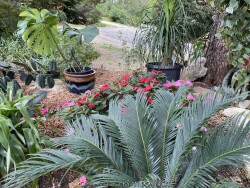

***Description for this plant available with future update!***Cycad / Sago Palm (Tropical), is also known as Cycas revoluta


This hardy Tree / Cane Cholla variety came to us from Yucca Pointe Nursery in Stillwater, OK where it grows outside in the owner Nathan Priest's display garden. This upright Cholla Cactus (Cylindropuntia imbricata) features magenta flowers and upright growth form are a unique addition to the garden. Native to arid clay soils in Western Kansas, Colorado, Oklahoma and parts of the southwestern United States and Mexico, the plant grows into a vicious unforgiving shrub if you get too close. From a distance however, this cactus has a place as one of the few upright cacti that can handle extreme cold. In fact, I have seen this species growing a few times in Lawrence, KS in desert gardens and even in full (dry) shade! Flowering in shade is doubtful though. With well drained soils and proper siting, this cactus can handle our excess rainfall in Eastern Kansas. We are testing this outside in our crevice garden among other hardy cacti and succulents! We will keep you posted. (2024)


This hardy Klein's Cholla came to us from Oklahoma nursery near Tulsa. This upright Cholla Cactus Cylindropuntia kleiniae) features pink/magenta flowers and upright growth form are a unique addition to the garden. Native to arid clay soils in New Mexico and parts of the southwestern United States and Mexico (even possibly Oklahoma), the plant grows into a vicious unforgiving shrub if you get too close. From a distance however, this cactus has a place as one of the few upright cacti that can handle extreme cold when kept dry. With very well drained soils and proper siting, this cactus seems to take our excess rainfall in Eastern Kansas. We are testing this outside in our crevice garden among other hardy cacti and succulents! We will keep you posted. (2024)


This hardy Cane Cholla came to us from Yucca Pointe Nursery in Stillwater, OK where it grows outside in the owner Nathan Priest's display garden. This upright Cholla Cactus (Cylindropuntia spinosior) features magenta flowers and upright growth form are a unique addition to the garden. Native to arid clay soils in Western Arizona and New Mexico and parts of the southwestern United States and Mexico, the plant grows into a vicious unforgiving shrub if you get too close. From a distance however, this cactus has a place as one of the few upright cacti that can handle extreme cold when kept dry. With very well drained soils and proper siting, this cactus seems to take our excess rainfall in Eastern Kansas. We are testing this outside in our crevice garden among other hardy cacti and succulents! We will keep you posted. (2024)
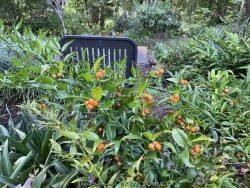

***Description for this hardy tropical available with future update!***
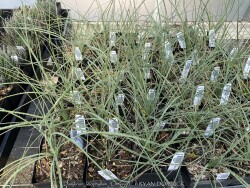

***Description for this plant available with future update!*** With extremely well drained soils and proper siting, this cactus seems to take our excess rainfall in Eastern Kansas. These and other hardy barrel cacti are perfect for a dry mounded xeriscape gardens under south facing roof overhangs where it gets no winter moisture. We are also testing this outside in our Lawrence, KS (zone 6a) crevice garden among other cold-hardy cacti, succulents, and yucca! Watch for future updates-Jan-2025